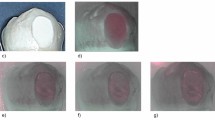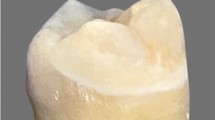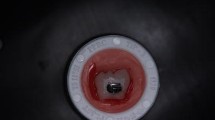Abstract
Objectives
The purpose of this study was to determine the color of white spot lesions.
Materials and methods
Human premolars were subjected to a pH cycling to produce artificial caries lesions and classified into groups (n = 10/group): group 1, immersion in deionized water; group 2, pH cycling without fluoride (F) application; group 3, pH cycling with immersion in 1,000 ppm NaF solution; and group 4, pH cycling with immersion in 5,000 ppm NaF solution. CIE L*a*b* color parameters of the tooth were determined using a spectroradiometer at baseline, after demineralization and after pH cycling. The extent of demineralization was evaluated by scanning electron microscopy (SEM) and electron microprobe analysis (EPMA).
Results
Significant degrees of color change (ΔE*) were observed after demineralization (p < 0.05). The changes were mainly due to an increase in lightness (L*) and a decrease in yellowness (b*). F application induced a significantly large ΔE* in group 4 (p < 0.05). The color reversal after remineralization was mostly due to the recovery of L*. SEM and EPMA verified that net mineral gains occurred in the subsurface lesions.
Conclusions
The initially white appearance of enamel caries was a result of changes of L* and b*. F treatment partially restored the color of white spot lesions.
Clinical relevance
F-driven remineralization induced both mineral gains and esthetic enhancement of artificially produced enamel white spot lesions. The increase of L* and the decrease of b* contributed to the color changes.



Similar content being viewed by others
References
Torres CR, Borges AB, Torres LM, Gomes IS, de Oliveira RS (2010) Effect of caries infiltration technique and fluoride therapy on the colour masking of white spot lesions. J Dent. doi:10.1016/j.jdent.2010.12.004
Kielbassa AM, Muller J, Gernhardt CR (2009) Closing the gap between oral hygiene and minimally invasive dentistry: a review on the resin infiltration technique of incipient (proximal) enamel lesions. Quintessence Int 40:663–681
Joiner A, Hopkinson I, Deng Y, Westland S (2008) A review of tooth colour and whiteness. J Dent 36(Suppl 1):S2–S7
Iwami Y, Hayashi N, Takeshige F, Ebisu S (2008) Relationship between the color of carious dentin with varying lesion activity, and bacterial detection. J Dent 36:143–151
Johnston WM, Hesse NS, Davis BK, Seghi RR (1996) Analysis of edge-losses in reflectance measurements of pigmented maxillofacial elastomer. J Dent Res 75:752–760
Yu B, Ahn JS, Lee YK (2009) Measurement of translucency of tooth enamel and dentin. Acta Odontol Scand 67:57–64
Kim JC, Yu B, Lee YK (2008) Influence of surface layer removal of shade guide tabs on the measured color by spectrophotometer and spectroradiometer. J Dent 36:1061–1067
Ko CC, Tantbirojn D, Wang T, Douglas WH (2000) Optical scattering power for characterization of mineral loss. J Dent Res 79:1584–1589
Jones RS, Fried D (2006) Remineralization of enamel caries can decrease optical reflectivity. J Dent Res 85:804–808
Tranaeus S, Al-Khateeb S, Bjorkman S, Twetman S, Angmar-Mansson B (2001) Application of quantitative light-induced fluorescence to monitor incipient lesions in caries-active children. A comparative study of remineralisation by fluoride varnish and professional cleaning. Eur J Oral Sci 109:71–75
Du M, Cheng N, Tai B, Jiang H, Li J, Bian Z (2011) Randomized controlled trial on fluoride varnish application for treatment of white spot lesion after fixed orthodontic treatment. Clin Oral Investig. doi:10.1007/s00784-011-0520-4
Kielbassa AM, Gillmann L, Zantner C, Meyer-Lueckel H, Hellwig E, Schulte-Monting J (2005) Profilometric and microradiographic studies on the effects of toothpaste and acidic gel abrasivity on sound and demineralized bovine dental enamel. Caries Res 39:380–386
ten Cate JM, Buijs MJ, Miller CC, Exterkate RA (2008) Elevated fluoride products enhance remineralization of advanced enamel lesions. J Dent Res 87:943–947
Son HJ, Kim WC, Jun SH, Kim YS, Ju SW, Ahn JS (2010) Influence of dentin porcelain thickness on layered all-ceramic restoration color. J Dent 38(Suppl 2):e71–e77
Joiner A (2004) Tooth colour: a review of the literature. J Dent 32(Suppl 1):3–12
Johnston WM (2009) Color measurement in dentistry. J Dent 37(Suppl 1):e2–e6
Li Q, Xu BT, Li R, Yu H, Wang YN (2010) Quantitative evaluation of colour regression and mineral content change of bleached teeth. J Dent 38:253–260
Lim HN, Yu B, Lee YK (2010) Spectroradiometric and spectrophotometric translucency of ceramic materials. J Prosthet Dent 104:239–246
Lim HN, Yu B, Lim JI, Lee YK (2010) Correlations between spectroradiometric and spectrophotometric colors of all-ceramic materials. Dent Mater 26:1052–1058
Krikken JB, Zijp JR, Huysmans MC (2008) Monitoring dental erosion by colour measurement: an in vitro study. J Dent 36:731–735
Kleter GA (1998) Discoloration of dental carious lesions (a review). Arch Oral Biol 43:629–632
Matis BA, Wang Y, Eckert GJ, Cochran MA, Jiang T (2006) Extended bleaching of tetracycline-stained teeth: a 5-year study. Oper Dent 31:643–651
Pinto CF, Paes Leme AF, Cavalli V, Giannini M (2009) Effect of 10% carbamide peroxide bleaching on sound and artificial enamel carious lesions. Braz Dent J 20:48–53
Tschoppe P, Neumann K, Mueller J, Kielbassa AM (2009) Effect of fluoridated bleaching gels on the remineralization of predemineralized bovine enamel in vitro. J Dent 37:156–162
Cochrane NJ, Cai F, Huq NL, Burrow MF, Reynolds EC (2010) New approaches to enhanced remineralization of tooth enamel. J Dent Res 89:1187–1197
Vieira AE, Delbem AC, Sassaki KT, Rodrigues E, Cury JA, Cunha RF (2005) Fluoride dose response in pH-cycling models using bovine enamel. Caries Res 39:514–520
Rodrigues E, Delbem AC, Pedrini D, de Oliveira MS (2008) PH-cycling model to verify the efficacy of fluoride-releasing materials in enamel demineralization. Oper Dent 33:658–665
Kawasaki K, Ruben J, Tsuda H, Huysmans MC, Takagi O (2000) Relationship between mineral distributions in dentine lesions and subsequent remineralization in vitro. Caries Res 34:395–403
ten Cate JM, Exterkate RA, Buijs MJ (2006) The relative efficacy of fluoride toothpastes assessed with pH cycling. Caries Res 40:136–141
Douglas RD, Steinhauer TJ, Wee AG (2007) Intraoral determination of the tolerance of dentists for perceptibility and acceptability of shade mismatch. J Prosthet Dent 97:200–208
LeGeros RZ (1990) Chemical and crystallographic events in the caries process. J Dent Res 69 Spec No:567–574, discussion 634–566
Lippert F, Lynch RJ, Eckert GJ, Kelly SA, Hara AT, Zero DT (2011) In situ fluoride response of caries lesions with different mineral distributions at baseline. Caries Res 45:47–55
Tanaka T, Yagi N, Ohta T, Matsuo Y, Terada H, Kamasaka K, To-o K, Kometani T, Kuriki T (2010) Evaluation of the distribution and orientation of remineralized enamel crystallites in subsurface lesions by X-ray diffraction. Caries Res 44:253–259
Zantner C, Martus P, Kielbassa AM (2006) Clinical monitoring of the effect of fluorides on long-existing white spot lesions. Acta Odontol Scand 64:115–122
Conflicts of interest
The authors declare that they have no conflicts of interest.
Author information
Authors and Affiliations
Corresponding author
Rights and permissions
About this article
Cite this article
Kim, Y., Son, HH., Yi, K. et al. The color change in artificial white spot lesions measured using a spectroradiometer. Clin Oral Invest 17, 139–146 (2013). https://doi.org/10.1007/s00784-012-0680-x
Received:
Accepted:
Published:
Issue Date:
DOI: https://doi.org/10.1007/s00784-012-0680-x




